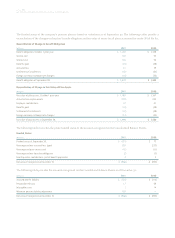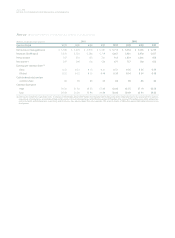American Express 2001 Annual Report Download - page 68
Download and view the complete annual report
Please find page 68 of the 2001 American Express annual report below. You can navigate through the pages in the report by either clicking on the pages listed below, or by using the keyword search tool below to find specific information within the annual report.
axp_66
NOTES TO CONSOLIDATED FINANCIAL STATEMENTS
Note 13 ❚SIGNIFICANT CREDIT CONCENTRATIONS
A credit concentration may exist if customers are involved in similar industries. The company’s customers operate in diverse
economic sectors. Therefore, management does not expect any material adverse consequences to the company’s financial position
to result from credit concentrations. Certain distinctions between categories require management judgment. The following table
represents the company’s maximum credit exposure by industry at December 31, 2001 and 2000:
December 31, (Dollars in millions) 2001 2000
Financial institutions(a) $ 17,075 $ 19,221
Individuals(b) 164,212 143,926
U.S. Government and agencies(c) 22,145 17,015
All other 18,018 25,398
Total $ 221,450 $ 205,560
Composition:
On-balance sheet 49% 54%
Off-balance sheet 51 46
Total 100% 100%
(a)Financial institutions primarily include banks, broker-dealers, insurance companies and savings and loan associations.
(b)Charge Card products have no preset spending limit; therefore, the quantified credit amount includes only Cardmember receivables recorded on the Consolidated Balance Sheets.
(c) U.S. Government and agencies represent the U.S. Government and its agencies, states and municipalities, and quasi-government agencies.
Note 14 ❚STOCK PLANS
Under the 1998 Incentive Compensation Plan and previously under the 1989 Long-Term Incentive Plan (the Plans), awards may
be granted to officers, other key employees and other key individuals who perform services for the company and its participating
subsidiaries. These awards may be in the form of stock options, stock appreciation rights, restricted stock, performance grants and
similar awards designed to meet the requirements of non-U.S. jurisdictions. The company also has options outstanding pursuant
to a Directors’ Stock Option Plan. Under these plans, there were a total of 48 million, 88 million and 123 million common shares
available for grant at December 31, 2001, 2000 and 1999, respectively. Each option has an exercise price at least equal to the mar-
ket price of the company’s common stock on the date of grant and a maximum term of 10 years. Options granted prior to 1999 gen-
erally vest at 331
⁄3percent per year beginning with the first anniversary of the grant date. Starting in 1999,options granted generally
vest at 331
⁄3percent per year beginning with the second anniversary of the grant date. The company also sponsors the American
Express Incentive Savings Plan, under which purchases of the company’s common shares are made by or on behalf of participat-
ing employees.
In 1998, the Compensation and Benefits Committee adopted a restoration stock option program applicable to existing and future
stock option awards. This program provides that employees who exercise options that have been outstanding at least five years by
surrendering previously owned shares as payment will automatically receive a new (restoration) stock option with an exercise price
equal to the market price on the date of exercise. The size of the restoration option is equal to the number of shares surrendered
plus any shares surrendered or withheld to satisfy the employees’ income tax requirements. The term of the restoration option,
which is exercisable six months after grant, is equal to the remaining life of the original option. Senior officers must be in compli-
ance with their stock ownership guidelines to exercise restoration options.
The company granted 3.0 million, 1.5 million and 1.3 million restricted stock awards (RSAs) with a weighted average grant date
value of $35.48, $43.46 and $36.25 per share for 2001, 2000 and 1999, respectively. Restrictions generally expire four years from
date of grant. The compensation cost that has been charged against income for the company’s restricted stock awards was $36 mil-
lion, $41 million and $38 million for 2001, 2000 and 1999, respectively.
























